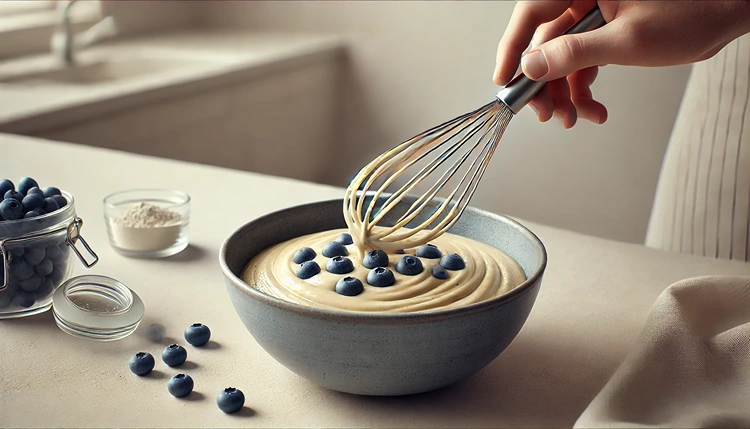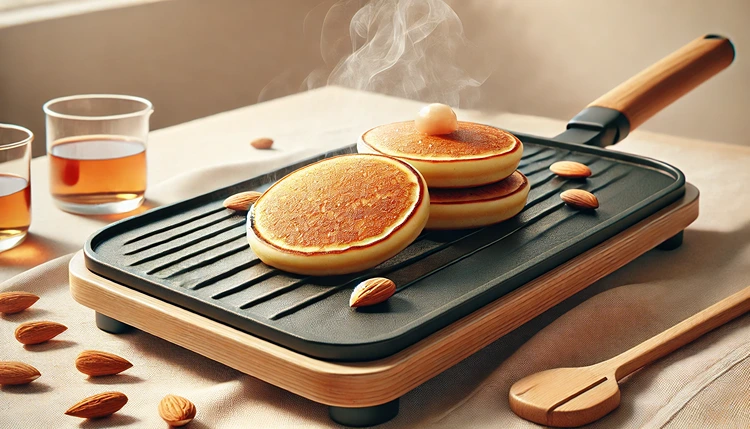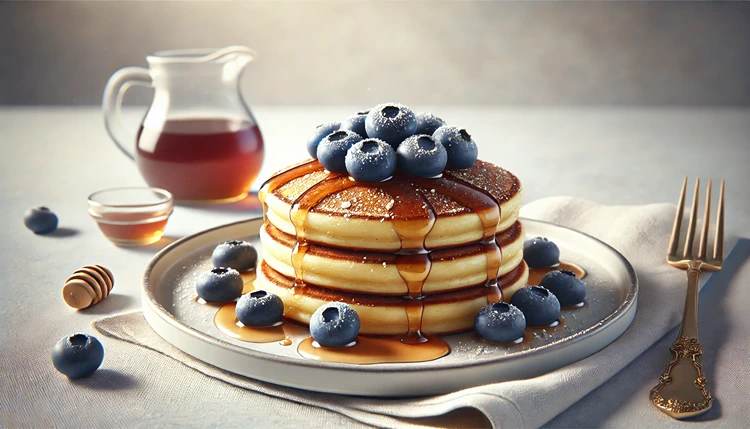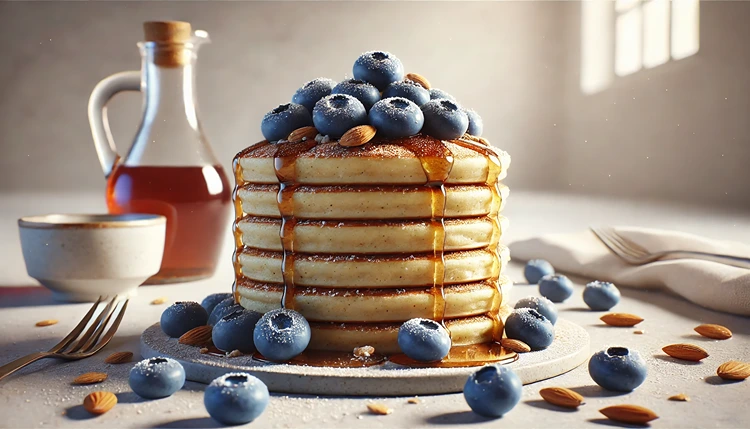Gluten-free pancakes have become a must-have breakfast option for those living a gluten-free lifestyle. When you’re looking for something that’s both satisfying and easy to whip up, gluten-free pancakes with almond flour are the way to go. They have a naturally sweet and nutty flavor, plus almond flour adds an extra layer of richness to the pancakes, making them deliciously soft. What’s even better? You can easily toss in some fresh blueberries for a burst of freshness and extra nutrients. You don’t have to compromise on taste, texture, or enjoyment!
Can You Make Pancakes Without Gluten?
Absolutely! Making gluten-free pancakes is not only possible, but they can be as fluffy and tasty as traditional pancakes. Almond flour is a key ingredient because it’s naturally gluten-free and adds a soft, moist texture. The lack of gluten won’t affect the fluffiness if you follow the right steps, and when paired with blueberries, these pancakes will be a crowd favorite.
Why Use Almond Flour for Gluten-Free Pancakes?
Almond flour is one of the most popular alternatives to wheat flour in gluten-free recipes. But why is almond flour such a good choice for pancakes? First off, it’s made from finely ground almonds, which means it’s full of healthy fats, fiber, and protein. It helps make your pancakes feel indulgent without the guilt. Almond flour also adds a mild, naturally sweet flavor that pairs beautifully with the blueberries, taking these pancakes to another level.
Helpful Hint:
When buying almond flour, look for “blanched” almond flour, which means the almonds have had their skins removed. This creates a finer texture, making your pancakes smoother and more cohesive.
What’s the Secret to Getting Fluffy Gluten-Free Pancakes?
The secret to fluffy gluten-free pancakes lies in how you combine your ingredients. When you’re using almond flour, it’s crucial to balance it with a good amount of leavening agents like baking powder to get the rise you want. Adding a touch of apple cider vinegar or lemon juice also helps activate the baking powder, making your pancakes lighter and fluffier. Don’t overmix the batter—just gently fold the ingredients together until combined. Letting the batter rest for about five minutes before cooking can also help the pancakes turn out fluffier.
Ingredients for Gluten-Free Pancakes with Almond Flour and Blueberries

Before we jump into the recipe, here’s a quick rundown of the ingredients you’ll need to make these fluffy, gluten-free pancakes. Each of these ingredients has a role to play, whether it’s adding flavor, structure, or sweetness.
- Almond flour – The star of the show, giving the pancakes a rich, nutty flavor.
- Baking powder – Helps the pancakes rise and become light and fluffy.
- Eggs – Provide structure and help bind the batter together.
- Almond milk – Adds moisture while keeping the recipe dairy-free.
- Maple syrup – Adds natural sweetness to the batter.
- Vanilla extract – Enhances the flavor of the almond flour and blueberries.
- Blueberries – Bursts of fruity freshness with every bite.
- Apple cider vinegar or lemon juice – Helps activate the baking powder for fluffier pancakes.
How to Cook Gluten-Free Pancakes Without Them Sticking?

One of the biggest challenges when cooking gluten-free pancakes is making sure they don’t stick to the pan. First things first, make sure you’re using a non-stick skillet or griddle. Heat the pan over medium heat, and once it’s hot, add a small amount of oil or vegan butter. If the heat is too high, the outside will burn before the inside cooks. So, keep the temperature moderate. Pour the batter in gently, and resist the urge to flip too early! Wait until you see bubbles forming on the surface before turning them over.
Easy Gluten-Free Pancakes with Almond Flour and Blueberries
Prep Time: 10 mins | Cook Time: 15 mins | Total Time: 25 mins

Ingredients
- 1 cup almond flour
- 1 tsp baking powder
- 2 large eggs
- 1/4 cup almond milk
- 1 tbsp maple syrup
- 1 tsp vanilla extract
- 1/2 cup fresh blueberries
- 1 tsp apple cider vinegar or lemon juice
- Pinch of salt
Instructions
- In a bowl, whisk together almond flour, baking powder, and salt.
- In a separate bowl, mix eggs, almond milk, maple syrup, vanilla extract, and apple cider vinegar.
- Combine the wet and dry ingredients, stirring gently until just combined. Fold in the blueberries.
- Heat a non-stick skillet over medium heat, and lightly grease it with oil or butter.
- Scoop 1/4 cup of batter onto the skillet for each pancake. Cook for 2-3 minutes on each side, or until golden brown.
- Serve warm with extra blueberries and a drizzle of maple syrup.
What Toppings Work Best with Gluten-Free Almond Flour Pancakes?
While blueberries are already folded into the batter, there are plenty of other delicious toppings that work perfectly with gluten-free pancakes. Some people like to keep it classic with extra maple syrup, but there’s no need to stop there. Fresh fruit like sliced bananas or strawberries can add a refreshing contrast to the pancakes’ richness. Want something indulgent? A dollop of coconut whipped cream or a drizzle of almond butter can elevate your pancakes to new heights. Don’t forget a sprinkle of chia seeds for a boost of fiber and omega-3s!
Helpful Hint:
To enhance the natural sweetness of the blueberries, warm them slightly in a pan with a splash of water and a teaspoon of maple syrup. This creates a quick blueberry compote that you can drizzle over the pancakes.
How to Store Leftover Pancakes
If you find yourself with leftover pancakes, don’t worry—they store well and make a great quick breakfast later in the week. Simply let the pancakes cool completely before placing them in an airtight container. You can store them in the fridge for up to three days. For longer storage, place them in a freezer-safe bag and freeze them for up to two months. When you’re ready to eat them, just pop them in the toaster or microwave for a quick reheat.
Helpful Hint:
Place a sheet of parchment paper between the pancakes before freezing. This will keep them from sticking together, making it easier to grab just one or two at a time.
How to Reheat Gluten-Free Pancakes
Reheating pancakes while keeping them fluffy can be tricky. If you’ve stored them in the fridge or freezer, the key is to maintain their texture without drying them out. For the best results, reheat them in the oven or toaster oven. Simply place the pancakes on a baking sheet, cover them with foil to prevent them from drying out, and warm them at 350°F (175°C) for about 5 to 7 minutes. If you’re in a rush, the microwave will work as well—just place a damp paper towel over the pancakes and heat in 20-second intervals until warm.
Helpful Hint:
To retain the original fluffiness when microwaving, don’t overheat the pancakes. Heating them in short intervals with a damp paper towel ensures they stay soft and moist.
Can You Make Gluten-Free Pancakes Ahead of Time?
Yes, gluten-free pancakes with almond flour are perfect for meal prepping! Whether you’re planning a lazy weekend breakfast or want to stock up for a busy week, these pancakes hold up well. Simply cook a batch, let them cool, and store them in an airtight container in the fridge or freezer. You can easily reheat them in the morning for a no-fuss, delicious breakfast. They also make a great snack or even a lunchbox treat for kids.
How to Modify the Recipe for Dietary Preferences
If you have other dietary restrictions or preferences, don’t worry—you can easily adapt this recipe. For those who are vegan, you can replace the eggs with a flaxseed or chia egg. To do this, mix 1 tablespoon of ground flaxseed or chia seeds with 3 tablespoons of water per egg replacement. Let it sit for about 10 minutes until it thickens. You can also swap out the almond milk for any other plant-based milk like oat, coconut, or soy milk if you have a nut allergy. These modifications will still give you fluffy, delicious pancakes without compromising flavor.
Is Almond Flour Healthier Than Traditional Flour?
Almond flour is often considered a healthier alternative to traditional wheat flour, especially for those following a gluten-free diet. It’s packed with nutrients such as healthy fats, fiber, protein, and vitamin E. Almond flour is lower in carbohydrates compared to regular flour, which makes it ideal for people watching their carb intake. Plus, its natural sweetness means you can reduce the amount of added sugar in recipes. The protein and fiber content also help keep you fuller for longer, making these pancakes a satisfying and wholesome breakfast option.
“Almond flour is a nutrient-dense alternative to wheat flour that’s perfect for gluten-free baking. It adds richness and flavor without compromising health benefits.”
Common Mistakes to Avoid When Making Gluten-Free Pancakes
While making gluten-free pancakes with almond flour is straightforward, there are a few common pitfalls that can affect your results. Here are some things to avoid:
- Overmixing the batter: Stir the ingredients just until they’re combined. Overmixing will make your pancakes dense and tough.
- Using the wrong heat: Cooking the pancakes over high heat can cause them to burn on the outside while remaining uncooked on the inside. Keep the heat medium-low to ensure they cook evenly.
- Not letting the batter rest: Allowing the batter to rest for a few minutes before cooking helps it thicken and results in fluffier pancakes.
- Flipping too early: Wait until bubbles form on the surface before flipping. If you flip too soon, the pancakes won’t cook through properly.
Why Almond Flour Pancakes Are a Great Gluten-Free Breakfast
Gluten-free almond flour pancakes are more than just a delicious breakfast—they’re a nutritious one, too. Packed with healthy fats and fiber, they help keep your blood sugar levels stable and prevent mid-morning energy crashes. Almond flour also contains more protein than regular flour, helping to fuel your day and keep you feeling full longer. Plus, they’re naturally gluten-free, making them a perfect option for those with gluten sensitivities or celiac disease. And when you add blueberries, you’re getting a dose of antioxidants and vitamins along with the sweet, tangy flavor they provide.
How Do You Know When Gluten-Free Pancakes Are Done?
Timing is key when cooking gluten-free pancakes, especially since almond flour can make them slightly more delicate than traditional pancakes. The best indicator is the bubbles on the surface of the pancake. When small bubbles begin to form and the edges look slightly firm, it’s time to flip. The pancake should be golden brown on the bottom. After flipping, the second side will cook a bit faster, so keep an eye on it. You want a nice golden color on both sides, and the pancakes should feel springy to the touch when done.
Serving Suggestions for Almond Flour Pancakes

Almond flour pancakes are a versatile breakfast base. They’re delicious on their own, but even better when paired with fun toppings and sides. Here are a few ideas:
- Maple Syrup and Fresh Fruit: Keep it classic with a drizzle of pure maple syrup and a handful of fresh berries or bananas.
- Nut Butter: For a protein boost, spread almond or peanut butter on top of the pancakes.
- Coconut Whipped Cream: Add a dollop of dairy-free whipped cream for an indulgent yet healthy treat.
- Granola and Honey: For some crunch, sprinkle granola on top and drizzle with a bit of honey.
Nutritional Information for Almond Flour Pancakes
| Serving Size | Calories | Carbohydrates (g) | Protein (g) | Fat (g) | Fiber (g) |
|---|---|---|---|---|---|
| 2 Pancakes | 200 | 10 | 7 | 16 | 3 |
| 4 Pancakes | 400 | 20 | 14 | 32 | 6 |
Weighing the Pros and Cons
Pros
- Gluten-free and perfect for people with gluten sensitivities or celiac disease.
- Rich in healthy fats and protein from almond flour, making it a nutritious breakfast option.
- Blueberries provide antioxidants, adding extra health benefits to your pancakes.
- Almond flour has a naturally sweet, nutty flavor that enhances the taste without needing much sugar.
- Quick and easy to make, taking just 25 minutes from start to finish.
- Freezer-friendly for meal prepping, allowing you to make batches in advance.
Cons
- Can be more expensive than traditional pancake ingredients due to almond flour and blueberries.
- Requires careful attention when cooking to avoid burning due to almond flour’s delicate texture.
- Not ideal for people with nut allergies, as almond flour is a key ingredient.
Frequently Asked Questions
Wrapping Up
Gluten-free pancakes with almond flour and blueberries are a simple, nutritious, and delicious breakfast option. Almond flour’s rich texture and natural sweetness, paired with the burst of juicy blueberries, create a perfectly balanced pancake experience. These pancakes are gluten-free, making them ideal for those with gluten sensitivities or celiac disease, but they’re also packed with nutrients that make them a great choice for anyone looking for a healthy breakfast. Whether you’re whipping them up for a weekend brunch or meal-prepping for the week ahead, this recipe is a winner. Enjoy experimenting with different toppings, reheating methods, and even storing them for later. Easy gluten-free pancakes with almond flour and blueberries are a go-to recipe that anyone can enjoy—no matter their dietary needs.

